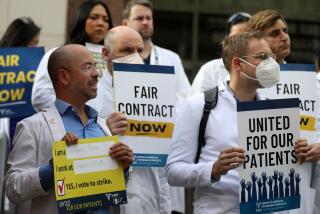Official Cites Crisis in L.A. Emergency Care System
State Health Services Director Kenneth Kizer said Wednesday that the Los Angeles County emergency care network is in serious jeopardy of breaking down.
“There are situations where people cry wolf,” he said. “In this case, in Los Angeles, the wolf is at the door. And he’s on the horizon elsewhere.”
Kizer’s comments came after a meeting in Los Angeles with representatives from seven Los Angeles-area hospitals who said that they may soon be forced for financial reasons to curtail their emergency room service, and that some defections of medical personnel are already taking place.
While acknowledging that “a potential disaster” lies ahead, Kizer said that the current state budget crunch makes a bailout of the Los Angeles emergency care system unlikely. Any funds set aside to avert the looming crisis will require cuts in other health services, he said.
At the meeting, Dr. Brian Johnston, president of the Los Angeles Society of Emergency Physicians, told Kizer that emergency service cutbacks by the seven hospitals will create “a medical black hole in the middle of Los Angeles.”
“You’ll be safer having a heart attack or an automobile accident in Mexico City” than in Los Angeles, he said, “because they have an emergency medical system there and if things keep going the way they’re headed at the present time, we won’t have one in Los Angeles.”
Doctors and nurses have already left their posts in several endangered emergency rooms for more secure jobs, Johnston said. The defectors include two doctors from California Medical Center, he said.
Officials at California as well as the Hospital of the Good Samaritan in downtown Los Angeles announced in May that they plan to downgrade their emergency rooms to standby status.
Cutbacks Delayed
At Kizer’s request, California and Good Samaritan agreed to delay their cutbacks until Aug. 1 to allow time for state and county officials to come up with a long-term solution to the problem faced by many inner-city emergency rooms: lack of reimbursement for treating increasing numbers of medically indigent patients.
The recent state budget crunch, however, has made solutions more difficult to find. Meanwhile, the vulnerability of other emergency rooms has emerged. These hospitals include Hollywood Presbyterian Medical Center, White Memorial Medical Center, Brotman Medical Center, Daniel Freeman Memorial Hospital and Queen of Angels Medical Center.
Kizer met Wednesday with representatives of those hospitals, who said that their emergency rooms are in jeopardy of down grading to standby status unless state and county officials provide funds to reimburse the hospitals for the cost of uncompensated care. They said they were banding together to try to save the system from collapse and avoid unnecessary deaths. Harvey Rudisaile, president of White Memorial in East Los Angeles, told Kizer that a domino effect of service curtailments by the seven hospitals would create a gap in emergency services stretching from Burbank to Watts and from East Los Angeles to Beverly Hills.
At risk will be the “millions of people who work, live and travel through Los Angeles,” said James D. Barber, administrator of Daniel Freeman Memorial Hospital in Inglewood. He added that discussions Wednesday did not produce a solution that would forestall the “disastrous scenario.”
In a letter to Los Angeles County supervisors last month, the president of the Hospital Council of Southern California, Stephen Gamble, said, “Based on past experience and knowledge of the impending situation, it is inevitable that some patients will die and many others will be severely impaired as a result of longer delays in reaching necessary medical care.”
Kizer said he understands “the potential disaster” for Los Angeles if certain key private hospitals curtail their emergency services. He said that any funds set aside to help prop up the emergency care system will have to come from other health services.
“I think we have to operate under the assumption there will be no net increases” in state health funding, Kizer said. The task will be “to re-prioritize (health) funds, assuming it’s a fixed pot.”
Allene Nungesser, administrator at Hollywood Presbyterian, said, “It appears our best hope is taking from Peter to give to Paul . . . and that’s difficult for some of us to accept when both Peter and Paul seem to be in terrible difficulty.”
More to Read
Sign up for Essential California
The most important California stories and recommendations in your inbox every morning.
You may occasionally receive promotional content from the Los Angeles Times.









